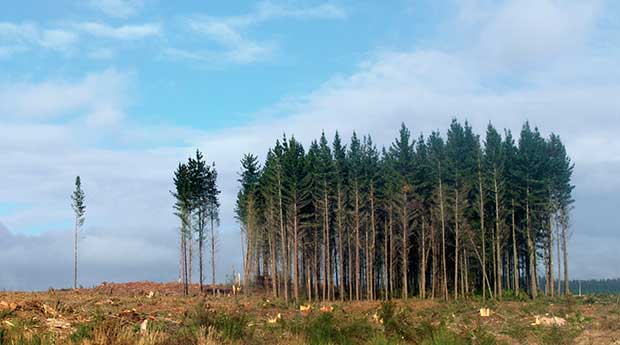Reduce the risks of windthrow – which trees that can weather a storm

Trees exposed to the elements, for example during felling, are far more vulnerable.
Windthrow is a natural phenomenon and part of forest renewal. It is impossible to prevent, but it is possible to reduce the risk to trees, property and life. Some of it comes down to tree choice and some of it comes down to smart planning.
Words Michelle Harnett
John Moore leads research into tree growth and quality at Scion, the Crown research institute that focuses on forestry. He says storm force winds which bring down trees cost land owners significant sums.
“Some trees survive extreme winds better than others,” says John.
“A century of observations in New Zealand forests suggests that rimu, totara and miro tend to weather storms better than kauri and beech. Smaller wind-resistant choices include Pseudopanax species (such as lancewood and five-finger), kapuka and kamahi.”
But don’t worry if you want to plant trees you love which may not be as wind-resistant says John; most trees adapt to the prevailing conditions, especially with carefully planned planting.
The factors to consider when planting a tree include:
• how wide and tall it is likely to grow?
• is there enough space for the tree canopy?
• what could it take with it if it fell?
• is there room for a wide and deep root system to develop?
• how quickly will a tree or trees mature?
Fast growing trees are very attractive, but they often will mature and reach heights that make them vulnerable to windthrow.
Mature trees are often designed to shed big limbs, which can be dangerous. Liquidamber trees are a classic example of a common, large and fast-growing tree with a habit of dropping sizeable branches.
“They may have lovely autumn foliage but I wouldn’t park my car under one,” says John.
The right planting patterns can also improve trees’ overall resistance to extreme winds. Lone trees are generally more vulnerable than trees planted in groups, and staggering rows to break up prevailing winds is also good practice.
Love this story? Subscribe now!
 This article first appeared in NZ Lifestyle Block Magazine.
This article first appeared in NZ Lifestyle Block Magazine.

